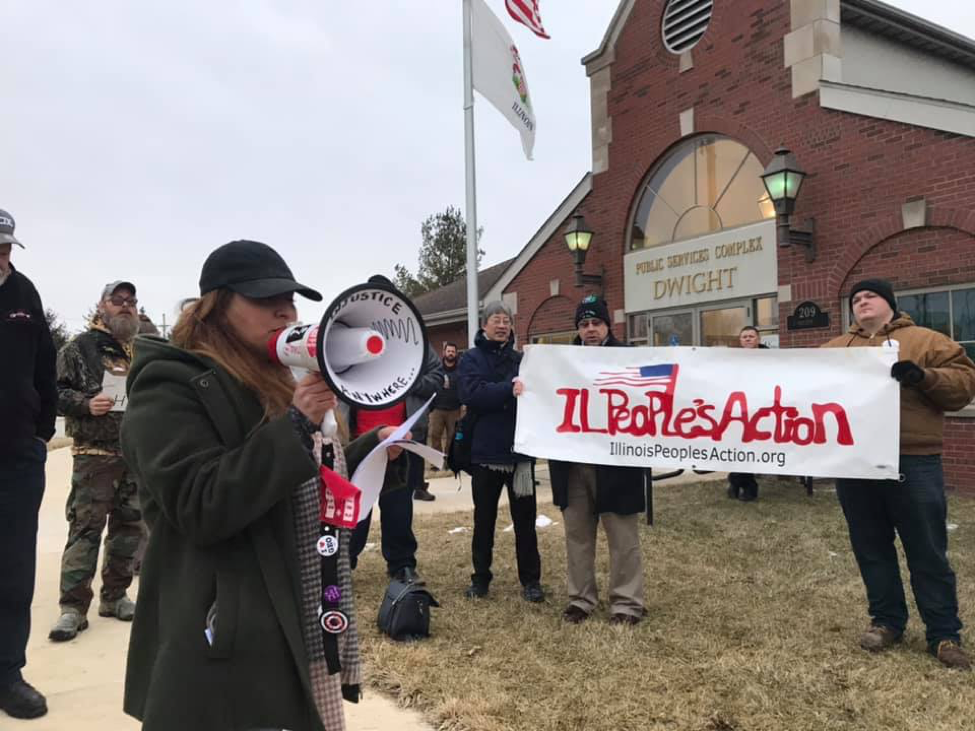
For decades, progressive and even leftist, organizers have ignored small town, rural and “red” areas. They have given them up, and their people, too, as lost causes, those too far gone, backwards, politically insignificant—the “deplorables,” one might say. This has been the trend for nearly 70 years in the post-World War II U.S. Organizers have abandoned areas where, generations ago, some of their strongest supporters led powerful movements.
A new podcast from People’s Action addresses this issue head-on.
Red Oklahoma used to have a more positive connotation. Because they were abandoned, poor white rural workers have looked to the political right and reactionaries to help address their plight. This trend created a stereotype that, unfortunately, wasn’t completely wrong. Racism, conservatism, and self-inflicted economic damage were all too common among white and rural workers. To many observers, it must have looked like a situation of “white labor only looked out for themselves and everyone else be damned!”
There is a resurgence for rural organizing, however, that holds promise for where the movement could go.
Yet we can’t forget the outright hostility and racism many migrants and minorities faced throughout the centuries, perpetrated by white capitalist interests and far too often embraced by white labor. The history of forced removal, slave labor, aggressive expansion, super-exploitation of migrant labor, and their justifications have been used to separate and suppress the working and laboring classes in the United States for centuries, since the beginning of colonization. To omit these facts would, mildly speaking, be a disservice to the millions of Black, brown, and Indigenous peoples that have fought and led the charge for progress and freedom. These groups have been on the front lines for centuries.
There was a time, however, where the trend was slowly reversed. The seeds were planted in the late 1800s and, while still delicate, emerged in 1905 through the Industrial Workers of the World (IWW) and continued through the Communist Party USA (CPUSA).

Discontent with the division, racism, and classism in the American Federation of Labor (AFL), which still exist to an extent to this day, the IWW set out to organize all workers. They organized the “unskilled” in small city textile mills, the “replaceable” miners in the rural mountain states, the multiracial dock and timber workers. They brought together young and old, men and women, immigrant and native, rural and urban, Black and white, and everyone in between, into “One Industrial Union Grand.” Organizing efforts and strikes in Montana, Arizona, Oregon, Washington, Utah, Massachusetts, and so many other places showed the strength of the labor movement outside of big city centers.
In one of the most explicit examples of resistance to state repression against unionization, largely white but multi-racial and immigrant laborers stood off against the U.S. Army at the Battle of Blair Mountain in 1921. It was this battle that created the term “redneck,” used to describe these laborers because of the red bandanas they wore around their necks and their largely socialist, communist, and anarchist political leanings. It’s a shame what “redneck” has turned into—maybe it’s time to reclaim its original meaning!

Founded in 1919, the CPUSA took in many former IWW members whose influence undoubtedly permeated throughout the party. They became the first fully integrated political party, organized “skilled” and “unskilled” workers, and were internationally minded. Most importantly, for the purposes of our attention here, they made concerted efforts to organize poor rural workers and farmers. They organized Penny Auctions to save farms, established the Sharecroppers Union to increase wages, conditions and benefits, and on occasion fought back sheriffs and the Ku Klux Klan, typically at the same time, throughout the 1930s.
They brought folks together and showed them it was not their neighbor who was their enemy, their competition—it was the bosses, the corporations. Through this organizing came the still unevenly distributed New Deal programs and massive public works projects of the 1930s in urban and rural areas, many of which still are in operation today. Politicians of every stripe were forced to listen to the working people regardless of where they were at. For some of those bigshots, their homes were at risk of becoming firewood if they didn’t.
There is no intention to romanticize this period, to suggest the possibility that regional and racial divisions were on their last leg. This was still the time of Birth of a Nation, the Bisbee Deportation, the Tulsa Massacre, and strong Dixiecrat control of the South. Many white “leftists” or “progressives” refused to work with the Sharecroppers Union. Both the IWW and CPUSA were hobbled by severe government repression. However, for a few fleeting decades these differences were being broken down.
Since then, there has been little concerted effort to bring everyone into the political sphere. Progressives retreated from the South and rural areas. Most aggressively highlighted by the Republicans’ racist Southern Strategy, both the Democratic and Republican parties have come to silent agreement that urban areas belong to the Democrats, rural areas belong to Republicans, and suburbs can be a tossup. Add in the factor of gerrymandering voting districts, there is scant need or incentive to engage anyone outside of those spheres. It is during this time that people were lost, and the nation as a whole lost a lot.
Recently, that decades-old trend seems to be reversing. Rural organizing has taken in a new breath of fresh air, and one new podcast looks to showcase that work.
People’s Action, a national network of local and community groups who organize everyday people to build power for a more just society, took on the task to show what some rural organizing looks like.
In their new podcast, To See Each Other, they visit five states to speak with rural on-the-ground organizers and learn the challenges they face. Rural areas have been discounted and abandoned, left to suffer from a myriad of issues, and few people are bothering to reach out to them. Loss of employment, drug addiction, unsafe drinking water, all combine with specially cultivated racist histories. There is little question that hundreds of thousands, millions, are suffering from these issues every day, and political leaders are not fighting for them. Some pretend to listen, the reactionary right especially, but the people are ultimately left ignored in a dust storm of patriotic jingoism.
To See Each Other offers a simple solution: Listen. It asks you both as a human being and a potential organizer to listen to those around you, to feel their suffering, their problems, and offer them an avenue through solidarity. No doubt most of the United States has heard of Flint, Michigan’s plight, and rightfully so. However, how many know that entire regions of Iowa don’t have safe drinking water either? How many are aware that state’s air quality can be some of the worst in the nation due to methane and the manure hogs produce? That combined, these issues create havoc for the entire Mississippi River watershed. Who knew that Iowa isn’t even alone in this issue? Who would think that an old rugged Iowa farmer with the vocabulary of a sailor could be front and center fighting for immigrant rights? This is what we miss when we discount rural areas.
Only the best organizers have ever asked what people have been feeling, what is at the heart of their issues, what the organizers can do for them and not the other way around. It’s a real lesson in having long, difficult, conversations that may take days, weeks and months to cultivate a relationship. These are conversations that need to happen, to see the person behind your assumptions. Without these opportunities, we fall into the same hole again and again, handing largely poor white rural workers over to reactionaries on a silver platter, who will stoke their fears and inflame gender, racial and regional tensions. In short, the whole podcast can be summed up with one well known phrase: You were given two ears and one mouth for a reason.
The podcast isn’t limited to these spaces. Towns across Illinois, where I live, have proven People’s Action right: There’s a lot more to small-town America than what many assume. Anna, a “sundown” town, had its first Black Lives Matter rally in June. Almost two years ago rural organizers managed to shut down a proposed ICE Detention facility in Dwight, and Illinois People’s Action was there. Bloomington residents have organized a COVID19 Mutual Aid Team, the Really Really Free Market, and fought back against Pay Day Lenders. Now, one of the active organizers in those efforts is running for city office.

Similarly, Springfield activist and longtime organizer John Keeting is running for state house representative in Illinois’ 96th district, incurring the wrath of many reactionaries along the way. Decatur Defense Action and Mutual Aid has helped provided and deliver free meals for those in need, while offering any assistance they can for those unable to pay utility bills during the pandemic. It’s one of many organizations that have signed onto the #NoAmerenShutoffs campaign.
Clearly, community organizing is alive and well in small-town and rural America. It has gone mainstream, too. Tyler Childers recently put out a message in support of Black Lives Matter and challenged his largely white rural listeners to imagine if it was their community that suffered these injustices. To him, there would be another Battle of Blair Mountain. Scrolling through the right feeds on Twitter, Facebook, Instagram, or Tik Tok, many would see hundreds of people challenging the prevailing narratives about white, rural, and southern America. We still have a long way to go until we can fully see each other. But often, it’s about taking that first step.
To See Each Other is streaming on all major podcast platforms and at their website: PeoplesAction.org.












Comments